Your Ultimate Guide to Brand Awareness
Can you imagine a world where nobody had ever heard of brands like Coca Cola, Kelloggs or Bandaids?
These companies have become so synonymous with the products they sell (soda, cereal, and bandages, respectively) that they’re permanently etched into consumer culture. But even if your product or service doesn’t have the same universal appeal as these household names, brand awareness is still extremely important.
After all, if your target audience doesn’t know (or remember!) your product exists, how are they going to purchase it or recommend it to their friends and family? Here, we cover everything you need to know about brand awareness, including why it’s so important, which companies do it well, and how you can take a design-led approach to achieve it for your own brand.
What is brand awareness?
Brand awareness is a measure of how familiar a consumer is with your brand. On one level, this encompasses their ability to recognize your brand’s name, logo and overall aesthetic—for example, you can probably automatically envision all of these things for a brand like McDonald's. But it’s important to remember that brand visibility and awareness are not necessarily the same thing. In order to truly embed your brand into the consumer’s psyche, they must be able to connect your brand name and logo with the specific products you sell, your point of difference and your brand values or personality.
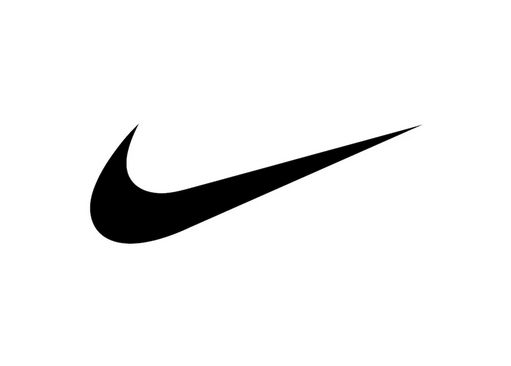
The world recognized Nike logo.
Instantly recognizable even without their brand name, the Nike ‘swoop’ is a great example of strong brand awareness in action.
Why is brand awareness important?
Think of brand awareness like meeting a potential romantic partner. If they don’t know you exist, they’re probably not going to be lusting after you (even if you happen to tick all the boxes of what they want in a partner!) In a similar way, if a consumer isn’t familiar with your product they’re unlikely to buy from you—even if they’re in the market for the specific product you sell!
On the other hand, say—for example—someone’s hairdryer breaks. If they start Googling replacements and come across a hairdryer brand they’re familiar with, they’re far more likely to go for that one over the competitors. For many consumers, they need to have encountered a product three or four times before they achieve that level of brand association—which presents additional challenges for marketers.
What brand awareness can lead to
Research from Savanta shows that brand awareness is the number one goal of 89% of marketers. That’s no coincidence! Consumer consciousness is an indispensable part of the marketing funnel, as it can lead to various desirable outcomes. These include:
Brand trust
Let’s be honest, not many people are going to buy from a brand they’ve never heard of—especially those who are more conservative consumers. In fact, research from Onbuy.com shows 71% of consumers need to recognize a brand name before they buy! On the other hand, if a consumer is familiar with your brand, this helps to build that all-important trust factor.
Conversions and sales
Strong brand awareness can mean the difference between a casual browser leaving your website or making a purchase. Sure, the content and look of your website are extremely important. But if you already have that strong foundation of brand awareness and trust in place, they’re far more likely to click ‘add to cart’ or schedule an appointment—and actually go through with it.
Brand loyalty
The importance of brand awareness goes beyond just that initial purchase. Once a consumer knows (and loves) your brand, they’re more likely to keep coming back to you, time and time again. This is known as brand loyalty.
Brand referrals
Even in the digital era, word of mouth remains a powerful marketing tool. If a customer is aware of your company and has formed a positive opinion on it, they can become an unofficial brand ambassador who helps spread the word about it. This can happen without them even buying your product! After all, even if they’re not in your specific target demographic, their friends, family, and colleagues might be!
How to increase brand awareness
Increasing brand awareness needs to be a multi-pronged approach. Firstly, you must have the foundations of your brand down pat, like a memorable brand name, visually-appealing logo and a polished and functional website. Without these in place, you’re unlikely to make a good first impression on a consumer, let alone an enduring one. Secondly, you must run marketing, advertising or social media campaigns to get your brand in front of the right people. Because as nice as it would be, it’s not as simple as ‘if you build it, they will come’ Here are some of our top tips for increasing brand awareness.
Find a unique selling proposition
The average modern person is exposed to around 5000 ads per day, according to marketing firm Yankelovich. So, even if a consumer comes across one of your ads, that doesn’t mean they’re actually really seeing or engaging with it. Many of us are so overexposed to advertising that we go into autopilot mode and don’t really take it in. That’s why it’s so important that your brand stands out against the crowd—whether that’s through a unique visual aesthetic, the use of humor or innovative ad campaigns.
Dollar Shave Club is a great example of a brand that does all three. While there are hundreds of shaving brands out there, this has become one of the most well-known in recent years. Why? Because they go against the grain (both literally and figuratively!) Whether it’s their Facebook ads, posters, YouTube videos or billboards, they use a rustic aesthetic, clever messaging and irreverent tone across everything they do.
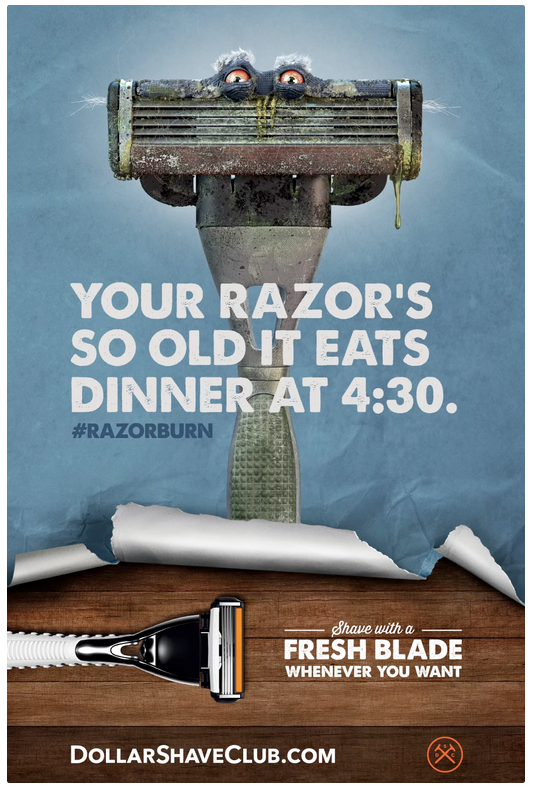
Be consistent
As a consumer usually needs to engage with your brand a few times before you’re on their radar, consistency is important. After all, if you’re showing up as a dark and moody brand one minute and fun and bubbly the next, it’s just going to confuse your audience and dilute your brand impression. While the exact content and avenues of your marketing efforts will likely change, your brand message and aesthetic should always remain the same. From a design perspective, setting up brand boards using a tool like Canva can help keep your fonts, colors and image styles consistent.
Use emotion
Ever heard the expression ‘People may forget what you said, but they’ll never forget how you made them feel?’ This rings true when it comes to brand marketing. Whether it’s making them feel sad, hopeful, inspired or angry, evoking emotion is an excellent way to get your audience to take notice and often, take action.
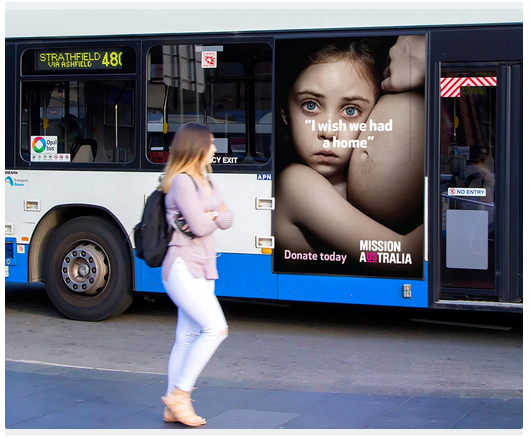
Mission Australia ad placed on public buses. Image via Behance.
The charity Mission Australia is an example of an organization that does this well. Combining a somber image of a child with a simple quote from her perspective, this bus advertisement is hard to ignore and will likely leave the viewer thinking about it for minutes or even hours to come.
The use of images of people—especially black and white photos—is an excellent way to elicit an emotional response and help your audience connect with your message. Canva’s White Monochrome Children World Refugee Social Media Graphic can easily be customized with your own imagery and text.
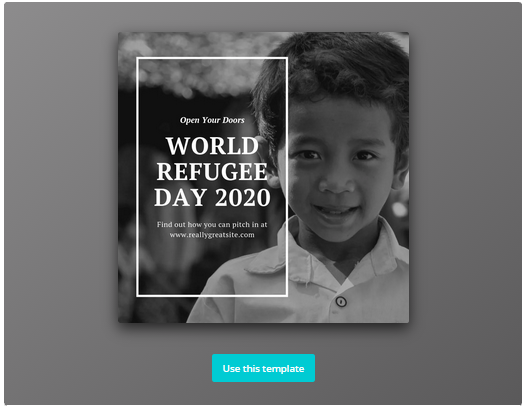
Make it targeted
When you make your consumer feels seen, they’re more likely to really see your brand. This is why it’s so crucial to tailor your advertising efforts to your target demographic. Platforms like Facebook, Instagram and Google Adwords make it easy to target your audience down to their age, location, interests, marital status and more. But it’s also important to make sure the content is well-targeted, including the tone of voice, images and brand colors you use in them.
How to measure brand awareness
While brand awareness is one of the most important metrics in marketing, it’s also traditionally been one of the hardest to measure. Take, for example, ads in a train station. It would be challenging to gauge exactly how many people actually paid attention to or took action from these while walking past. When it comes to digital advertising, it becomes a little easier. For example, Facebook has an ad recall lift feature for advertisers, where they ask users whether they remember seeing the ad within the two days.
Social listening tools are another great digital platform for measuring brand awareness, as they allow you to monitor mentions of your brand across websites and social media.
Some are even advanced enough to automatically analyze the sentiment towards your brand in these mentions, whether that’s negative or positive. Surveys, focus groups, market are also useful tools for measuring brand awareness.
How successful companies have achieved strong brand awareness
Spotify
Ask someone to name a music streaming service and changes are, they’ll say Spotify. The Swedish company has become a clear leader in the music industry over the last decade, partly due to its memorable brand personality and aesthetic. However, one of the biggest ways they have achieved brand awareness is through their focus on personalization.
For example, the brand utilized user data in a risky-yet-effective way when they unveiled their ‘2018 goals’ campaign. Here, they released their anonymous user data in these hilarious billboards which unsurprisingly, went viral.
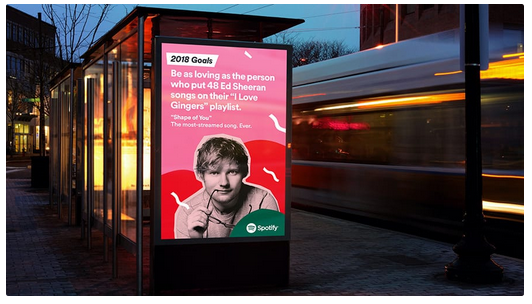
They also use personalization in their interactions with current users. For example, their year in review ‘wrapped’ campaign which gave users a roundup of their listening habits throughout the year and even auto-created a playlist of their most-played tunes. Naturally, many users shared their ‘years in review’ on social media with their followers, which further enhanced Spotify’s brand awareness.
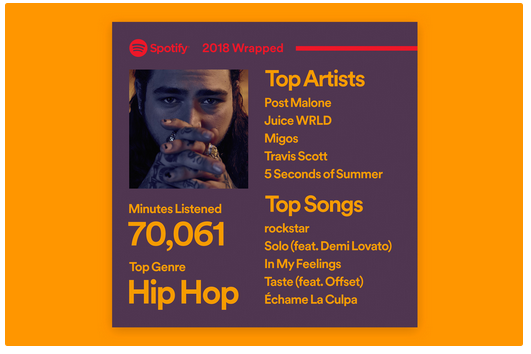
Creating an eye-catching infographic is a great way to increase your own brand awareness, thanks to their shareability factor. Plus, research shows that consumers are far more likely to retain visual information than text. Canva’s Music Genre infographic is an excellent place to start.
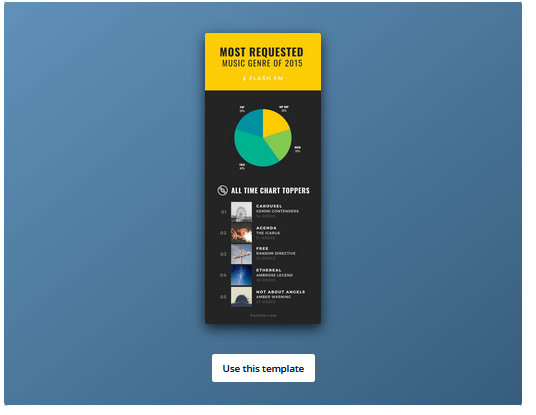
Floralip Butter
Sure, food brands can shout from the rooftop how tasty their products are. But what’s far more effective is to show, not tell. Here, Swiss butter company Floralip has done this without even using words. Through their creative use of negative space, they’ve illustrated just how mouth-watering their offering is—which is likely to stay in the forefront of the consumer’s mind next time they need to buy butter!
Want to achieve a similar effect for your own food brand? Incorporating photos that show the texture of your products is a great way to leave users craving it long after they see your ad. With a simple split design, Canva’s Honey Dipper Twitter Post template can help you get the look.
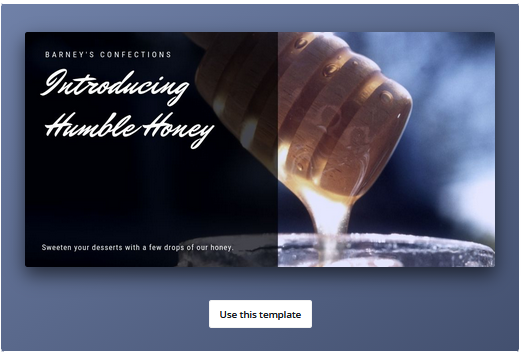
The Shameless Podcast
When the founders Zara McDonald and Michelle Andrews first launched the Shameless podcast in 2017, they took a guerilla marketing approach in raising brand awareness. To ensure they were reaching their target demographic of young women, they went to local universities and put up posters in bathroom stalls! It worked, as the show quickly gained a loyal following and is now one of the most streamed podcasts in Australia.
Don’t underestimate the power of more traditional methods like posters when it comes to increasing brand awareness. When well-executed, they can be an effective way to cut through the advertising noise and reach your target demographic. Canva has hundreds of poster templates like this Yellow and Pink Motivational Poster template that are ready to make your own.
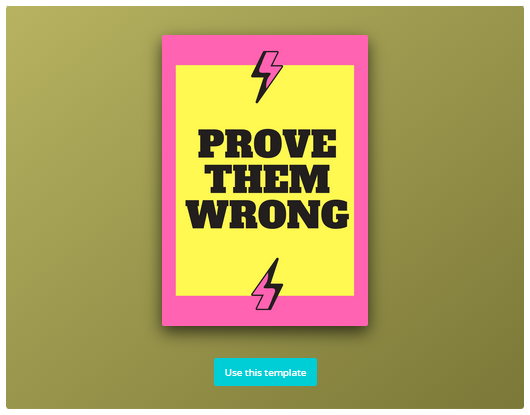
Whether you’re just about to launch your business or it’s already well established, raising brand awareness should be one of your top marketing priorities. After all, it affects every stage of the consumer’s buying journey.
By using the tips and examples in this article, you can generate the brand awareness that captures—and holds—your target audience’s attention for long beyond just that first impression. In doing so, you’ll build the trust they need to make their first purchase and solidify brand loyalty so they continue buying from you—and raving about your business—for years to come.
View original content here
Related News: